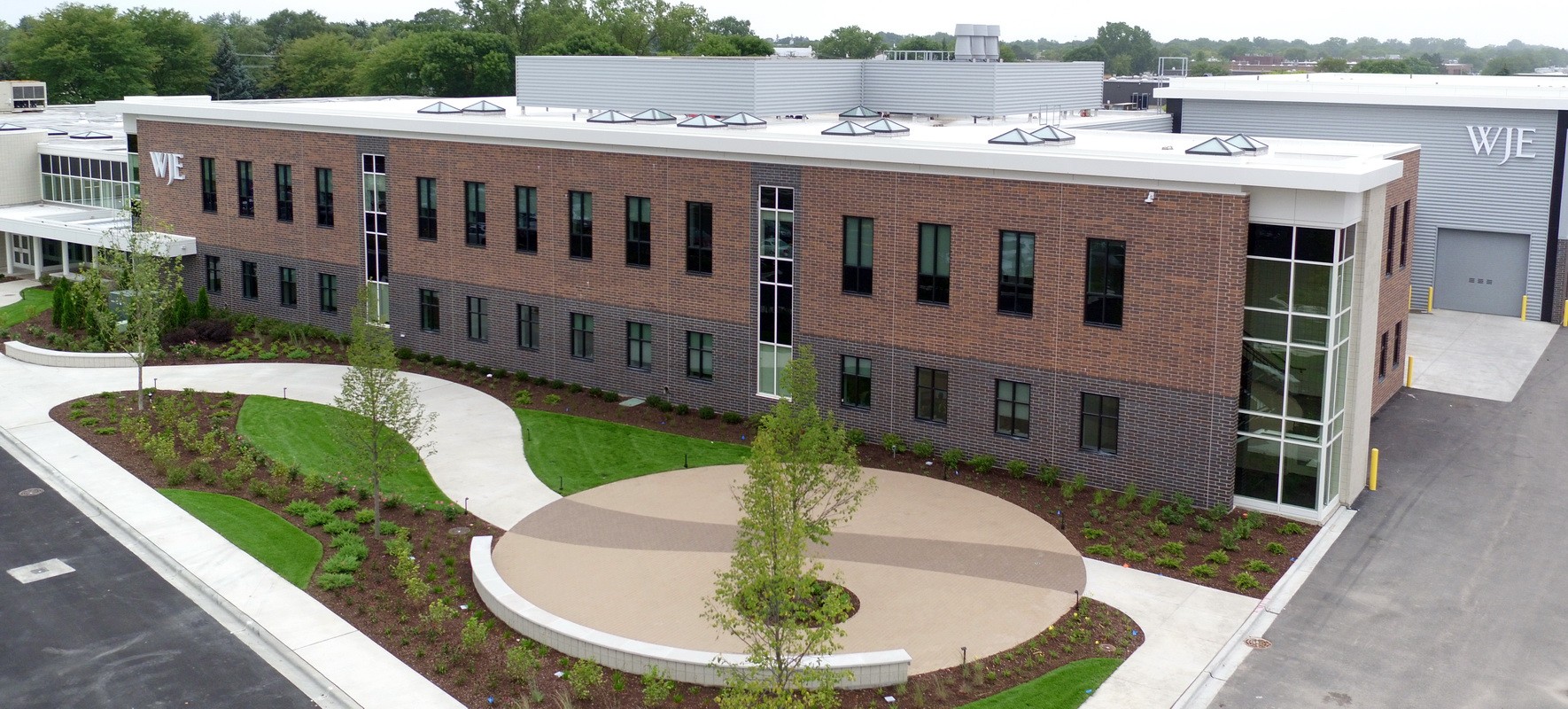Sustainability at WJE
Efforts on Our Headquarters Campus


WJE is firmly committed to using our resources responsibly to support the long-term sustainability of our campus and the environment in which we live and operate. Our corporate headquarters, located in Northbrook, Illinois, comprises five buildings spread across a 10-acre campus. The south and north buildings serve as the primary focus of our sustainability efforts, and the remaining three buildings are utilized as warehouses for laboratory samples and documents. The south building, renovated in 2006, provides 62,000 square feet of office space, while the north building, constructed in 2017, consists of 30,000 square feet of office space and 35,000 square feet of laboratory space.
Waste Reduction and Recycling
Since 2021, we have made significant progress in waste reduction and recycling. Through our strategic partnership with a recycling processor, we have successfully recycled 5 tons of cardboard and 15 tons of office paper. These materials are directly delivered to end-users, including Georgia Pacific, Kimberly-Clark, and Weyerhaeuser. Additionally, we have successfully reduced disposable cup usage by 75 percent, equivalent to more than 2,600 cups per month, by standardizing the use of coffee mugs. We have also implemented separate recycling for aluminum cans and plastic bottles, as well as a composting program for restroom paper towels and kitchen waste, resulting in a more-than-1,000-pound reduction in landfill waste.
Building Monitoring and Automation
Since 2012, our facilities team has diligently tracked and analyzed campus-wide energy usage to promote sustainable performance. In 2022, we began uploading our energy, waste, and water usage data to the Energy Star Portfolio Manager website, in alignment with the growing adoption of this platform by cities and states for regulatory purposes. We have also implemented cloud-based energy monitoring through sub-metering on twenty-one HVAC and laboratory equipment units to identify and address inefficiencies. Additionally, we deployed indoor air quality (IAQ) sensors that measure various parameters, including total volatile organic compounds (TVOC), carbon dioxide (CO2), and particulate matter (PM2.5 and PM10), ensuring optimal ventilation and occupant comfort.
Energy Consumption
Over the past decade, we've reduced our electricity consumption in the south building by a remarkable 40 percent, equivalent to 900,000 kilowatt-hours. This achievement was made possible through the utilization of advanced lighting technology, building controls, HVAC maintenance, and retro-commissioning. Furthermore, our decision to electrify the building during the 2006 renovation has paved the way for the south building to become net-zero through on-site generation and other sustainable methods. In 2023, we upgraded the automation system to allow for integration of the IAQ sensors and to optimize HVAC usage during non-operating hours, resulting in energy savings of over 100,000 kilowatt-hours. We actively participate in local electric utility energy efficiency and rebate programs to further reduce campus-wide energy consumption.
On-Site Generation
In 2022, we installed a 128kW photovoltaic (PV) system on the north building, capable of generating 168,000 kWh per year. This solar panel system accounts for 5 percent of our 3.3 million kWh campus electrical usage. To accommodate the high energy demand of our fully electrified south building and the continuous temperature requirements of our laboratory spaces, we sized the PV system to avoid net metering while serving as a proof-of-concept for future implementations. Our goal is to install an additional PV system on the south building after an end-of-life re-roof. The south building roof can accommodate a PV system capable of generating half the south building electricity usage with current PV technology. Additionally, we have a standby natural gas generator on-site, primarily for emergencies, but we are committed to operating it during high-demand times to shed approximately 30–50 kilowatts of energy from the grid.
Native Pollination Garden
In October 2023, a native plant pollinator garden was established on the Northbrook campus. WJE plans to quadruple its size in the coming years, aiming for a self-sustaining ecosystem. Plants like Penstemon digitalis (commonly referred to as Beard Tongues), known to attract bees and hummingbirds due to its tubular flowers, and Rudbeckia fulgida, a butterfly favorite with its daisy-like yellow-orange rays, are integral to the garden. By avoiding chemical fertilizers, mechanical watering, or pesticides, we're ensuring a healthier environment for both employees and pollinators. Our facilities team retains detailed records on plant species and their care.
Moving Forward
Our Northbrook campus facilities team is investigating the feasibility of green roofs, additional solar panels, and net-zero construction.



































